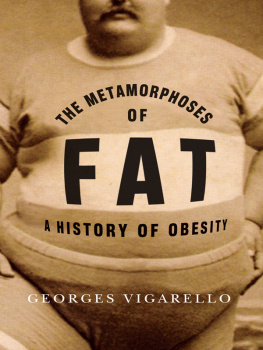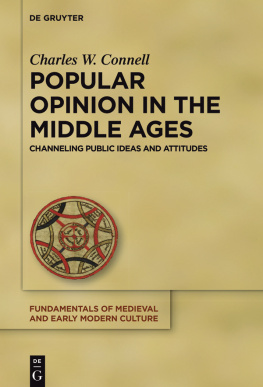THE METAMORPHOSES OF
FAT
European Perspectives
EUROPEAN PERSPECTIVES
A Series in Social Thought and Cultural Criticism
Lawrence D. Kritzman, Editor
European Perspectives presents outstanding books by leading European thinkers. With both classic and contemporary works, the series aims to shape the major intellectual controversies of our day and to facilitate the tasks of historical understanding.
For a complete list of books in the series, see .
THE METAMORPHOSES OF
FAT
A History of Obesity
Georges Vigarello
Translated from the French by C. Jon Delogu

COLUMBIA UNIVERSITY PRESS NEW YORK
COLUMBIA UNIVERSITY PRESS
Publishers Since 1893
New York Chichester, West Sussex
cup.columbia.edu
Copyright 2013 Columbia University Press
Georges Vigarello, Les metamorphoses du gras: histoire de lobsit (Paris: Seuil, 2010) Cet ouvrage a bnfi du soutien des Programmes daide la publication de lInstitut Franais. This work, published as part of a program of aid for publication, received support from the Institut Franais.
All rights reserved
E-ISBN 978-0-231-53530-4
Library of Congress Cataloging-in-Publication Data
Vigarello, Georges.
[Mtamorphoses du gras. English]
The metamorphoses of fat: a history of obesity / Georges Vigarello; translated from the French by C. Jon Delogu.
pages cm.(European perspectives: a series in social thought and cultural criticism)
Includes bibliographical references and index.
ISBN 978-0-231-978-15976-0 (cloth: alk. paper); ISBN 978-0-231-53530-4 (e-book)
1. ObesitySocial aspectsHistory. I. Title.
RC628.V5413 2013
362.196398dc23 2012029197
A Columbia University Press E-book. CUP would be pleased to hear about your reading experience with this e-book at .
Cover Design: David Drummon
References to Web sites (URLs) were accurate at the time of writing. Neither the author nor Columbia University Press is responsible for URLs that may have expired or changed since the manuscript was prepared.
CONTENTS
In one of her letters from the end of the seventeenth century, Elizabeth Charlotte, the Palatine Princess, gives the reader this image of herself: my waist is monstrously wide, I am as square as a cube, my skin is red, speckled with yellow. Then come anecdotes naming the symptoms of various troubles and ailments: spleen pain, colic, vapors, and a loss of balance worsened by bumpy carriages. Being big is a disadvantage, perhaps even a curse.
The big person, however, was not always so strongly denounceda fact that justifies historical inquiry. Massive bodies can be praised in the Middle Ages, for example, as denoting power and ascendancy. Similarly, in times of hunger, admiring praise is accorded to lands of plenty [pays de cocagne] with all-you-can-eat banquets and visions of endlessly stuffing oneself. Force is associated with the large hearty meal. Accumulating pounds is seen as health insurance. And social privilege is signified through a display of ones own size. These ideas are probably complicated as well, though, because even in the Middle Ages they are contested by the sermons of clerics and the reservations and beliefs of doctors and even by the delicately phrased demands of courtly codes. Nevertheless, they are impressive, immediately recognizable signs that lend the big person power and conviction.
A definitive break however takes place with the advent of modern Europe. The closely contemporary testimonies of Saint-Simon in France and Samuel Pepys in England denigrate a lazy, fat priest, Prestige and models change. The rough tables of olden times heaped with food are no longer classy, and accumulating pounds of flesh is no longer a sign of forceful reserves but rather of a certain loss of control and grossness.
The history of being big is the story of these reversals. The development of Western societies promotes a tendency toward slimmer bodies, a keener supervision of physical contours, and an increasingly alarmed refusal of heaviness. This of course brings changes in what counts as big and a barely imperceptible but steady privileging of lightness. This in turn strongly exacerbates contempt for big people, who find themselves increasingly discredited. Voluminous individuals fall further and further below standards of refinement, while beauty is ever more associated with the thin and slender.
This same discredit takes on a different content over time and these changes further justify a history of bigness. The vision of the fault shifts, thus revealing how much the bodys appearance, with its real or supposed flaws, is linked to a history of cultures and sensibilities. Medieval criticisms, formulated by clerics and diffused with some success in the fourteenth and fifteenth centuries in advance of our modern era, insist on the capital or deadly sins. These criticisms assail the passions, single out the glutton, and denounce his lack of dignity. They condemn avarice, while modern criticisms insist on a lack of dexterity and efficiency. The big, now fat, person becomes a figure of the inapt, the unfitflabby and inert. Their fault is a deficit of doing, an insufficiency of power and action. Annibal Carraches caricature portraits from the seventeenth century are the best illustrations: groups of men with oversized stomachs and short limbs stuck in poses of heaviness. The flaw of the fat person in modern times is lack of dynamism and a capacity for doing. The dominant idea becomes fat = no power. The fat person can also provoke collective denunciations, as when the full chests of the wealthy are pointed to as a sign either of their rapaciousness or their true inefficiency. With their round tummies and degraded bodies, aristocrats and abbots at the end of the eighteenth century are the classic examplesprofiteers that revolutionary ideas will squeeze down, then out, thus exposing their uselessness.
The criticism of the fat person thus participates in the immense shift within Western societies that deepens the space given over to psychologiestaking distance from older moral classifications and instead developing an infinite array of personal differentiations and types of behavior.
In other words, this stigmatization reflects above all an accentuation of norms that in Western societies dictated ever stricter rules and precise guidelines for physical appearance and the expression of self. It can also reflect differences that are upheld between male and female genders as well as between social groups. For example, public condemnation is more severe toward the female body, which has been traditionally expected to be supple and fluid. Inversely, judgments have been more tolerant toward the dominant sex whose ascendancy has traditionally allowed for a more imposing voluminous size. The court of the great king in the seventeenth century, for example, does not lack for princes of a certain rotund stature, just as in the nineteenth-century world of the bourgeois there is no shortage of figures whose prestige is marked by a certain hefty, not to say heavy, allure. Here, too, social and cultural polarities, the differences constructed between men and women, inevitably traverse both positive and negative judgments.
A history of the body must give an account of both these evaluations of appearances and the history of their ever more explicit elaboration.
A sign of this growing exactitude is the statistical calculation and report of body weight that becomes customary by the end of the nineteenth century, just as an increasingly industrious vision of bodies and anatomies is also taking hold. It will take time before the bathroom scale and related personal tools arrive in private spaces in the twentieth century, marking a new requirement for self-maintenance that the evidence of periodic self-weighing fulfills. The presence of the scale has become part of everyday life, almost natural, so spontaneous that it can make us forget how much our judgments of weight developed and refined themselves before the advent of numbers and tests. But it is this refinement and its diversification and individualization that are central to a history of big people.
Next page









